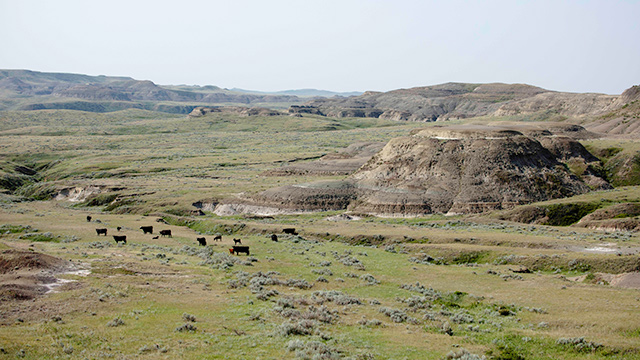
Grazing in Grasslands National Park
Grasslands National Park
Have you ever wondered why there are cows in a national park? Grazing is an important tool in maintaining the health of the prairie ecosystem. It supports the management of native grasses and invasive vegetation, and well-planned grazing contributes to conserving habitat for several Species at Risk such as the Greater sage-grouse, Swift Fox, Sprague’s Pipit and the Chestnut-collared Longspur.
Working with local ranchers

Grazing, whether bison or cattle, on the mixed-grass prairie plays a vital role in the health of the ecosystem. The large tracts of unbroken prairie in southwestern Saskatchewan still exist because they were, and continue to be, a working landscape. Ranchers were able to earn a living off the land while preserving this unique ecosystem. Today many native flora and fauna continue to thrive when the livestock grazing is managed in a way that promotes a balanced and healthy ecosystem. The land stewarded by private ranchers also connects former community pastures, national and provincial parks, and lands managed by non-government organizations increasing the possibility of wildlife movement on the landscape.
Grasslands National Park administers more than a dozen active, multiyear grazing and haying agreements with ranchers to help manage the mixed grass prairie from a conservation perspective. This approach will continue for the foreseeable future as a way to manage the grasslands for generations to come.
Could bison graze the land instead of cows?
Some of the grazing that occurs in the West Block of the park, is done by the Plains bison, in an area consisting of 18,074 hectares. Bison require a more robust style of fencing than cattle and this type of fencing is currently not in place in all areas of the park. In addition, bison are not the best option for certain objectives like intensive grazing to control invasive species.
Well-managed cattle grazing remains a very important tool for improving ecosystem health and habitat for Species at Risk in Grasslands National Park. However, bison are a species of conservation concern, and the Grasslands National Park bison program aims to ensure the persistence of a healthy, genetically viable and diverse herd. The park is currently acquiring data to assess the feasibility of expanding the bison herd (and bison grazing) to other areas of the West Block.
Helping hands for sage-grouse recovery
In 2014, Parks Canada began work with local ranchers to support the recovery of the Greater sage-grouse, and other species at risk, by implementing carefully planned grazing by cattle and co-managing large areas of land.
Through this program, Grasslands National Park established connections with local land managers and started to adopt methods to move cattle on the landscape without using permanent fences (e.g., herding, temporary electric fence, salt/mineral placement), thus removing a potential source of mortality for Greater sage-grouse.
So, the next time you see cattle in the park, we hope you see them as conservation in action!
- Date modified :